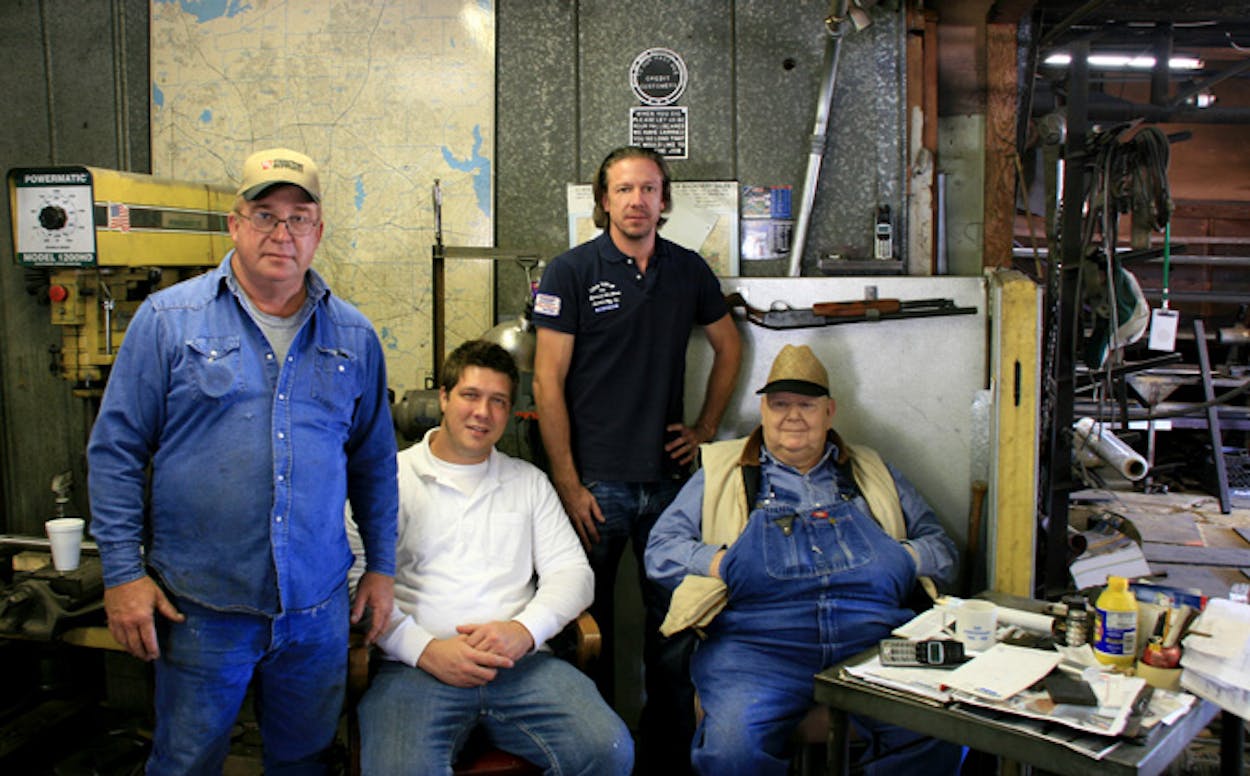With the recent surge in barbecue’s popularity, the modern-day pit master is getting more attention than a grease fire in a barbecue pit. These smoked meat craftsmen rely heavily on skill and experience, but their most important tool is a dependable pit.
A.N. Bewley Fabricators has been bending, slicing and welding steel for high-quality barbecue pits since 1960, the year Arthur Norman Bewley, a Dallas-based welder, rented the corner of a metal shop and began moonlighting as a pit maker.
Pit masters across Texas—and in places as far away as Okinawa, Japan—soon began clamoring for his models, which he made one at a time, by hand. His passion turned into a full-time job, with his small company turning out pits that can easily cost $20,000.
Today, there is only a tiny sign identifying his factory, and the front door is hard to find. The hulking smokers that sit out front are advertisement enough. Bewley had a stroke a few years ago, so now his son-in-law, Larry Lewis, runs the place.
The barbecue boom has made their smokers more popular than ever. Lewis and Bewley could expand to meet growing demand and maybe install an assembly line, but they still prefer to make their pits one at a time.
Last month, I sat down with Mr. Bewley and Mr. Lewis to talk about their livelihood:
Daniel Vaughn: So how did you get into the business?
A.N. Bewley: I got tied in with Mr. Oyler, who owned Oyler’s Barbecue in Mesquite. He had built five pits, but put a steel firebox in every one of them. He ended up having to replace those fireboxes, and because I knew a bit about welding refractory, which works better with high temperatures, I helped him create new, round fireboxes and line them with refractory.
DV: How did you come to meet Mr. Oyler?
ANB: His shop was in Dallas, just down the street from Kemp Sheet Metal Works, where I worked at the time. One day he stopped into Kemp and asked the owner, Mr. Kemp, if he could build pits. Mr. Kemp asked me to do it instead.
DV: Let’s back up: How did you get involved with Mr. Kemp and get into welding in the first place?
ANB: I was born on a farm in East Texas, but all my life I said I was going to be a welder when I grew up. When I was little, growing up, I watched them lay in the pipeline through the country. I’d walk up and down along it, seeing how they put it in. Anyway, I like to see the steel melting from a torch. [He laughed.]
I ended up buying a one-way ticket to Dallas because there wasn’t anything out there for me, so here I come. I worked at a few places — Chicago Bridge and Iron, which was actually in Amarillo, and Austin Brothers Steel around here. Eventually I ended up at Kemp. It was one of the longest jobs I had.
DV: When you were working with Kemp, they had their own line of pits that they made?
ANB: Yeah.
DV: And on the side you made the Oyler pits for Mr. Oyler. Did he already have a specific pit design when he came to you?
ANB: He had a small pit with a door raised up like this, ones that opened up out like they do today. But we made a lot of changes on the pit when I started building.
DV: So basically, you helped design the Oyler pit.
ANB: Yeah. It is now still basically the same thing that it was I was building back in those days. I drew the rotisserie pit, every part that went in it.
DV: You said you started off on your own by building two rotisserie pits. Who were those for?
ANB: Penny Pinchers BBQ.
DV: And so what did Mr. Kemp think about you going off and building pits on your own? That was taking away some of his business, right?
ANB: Oh, no. Don, his son, would call me up every now and then, and he’d say, you remember so-and-so, and I’d say, “Yeah.” “Can you handle it?” And I’d say, “Yeah.” And he’d say, “I’m going to give them to you.”
Larry Lewis: I think Mr. Kemp always felt that the barbecue pit deal was kind of more of a nuisance to his business, so every time somebody would come in to talk about barbecue pits, he’d say, “Well, talk to Bewley.”
DV: You’re partially known for the pit-fired rotisserie. How much of the business is those rotisserie pits?
LL: We built one this year, and it was the first we had built in two years, I think.
DV: So now you work more on the flat-rack pits? How many of those did you do?
LL: We build fifteen on a good year. It kind of varies a lot. We’ll have five or six places that will order pits, and then we may not build a pit for a couple of months. That’s one reason we’ve tried to stay diversified through the years, and we’ve had some other accounts in our stainless work that we do.
But right now, the pit business has been real good—we’ve been real busy. And I hope that’s a sign of good things to come.








